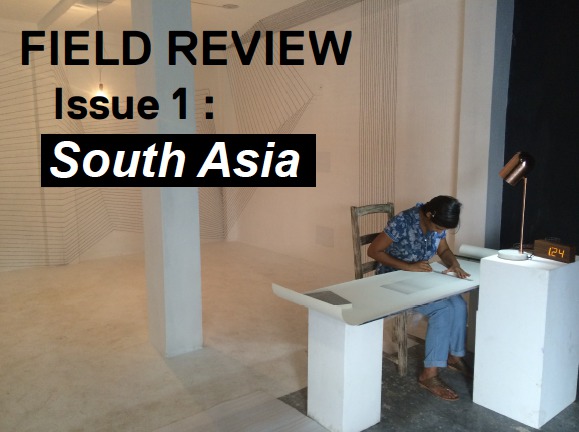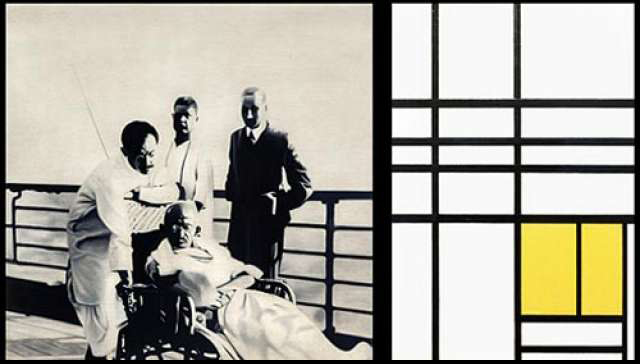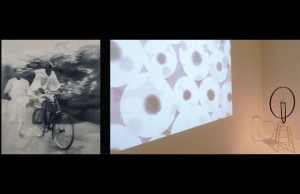FIELD REVIEW : South Asia

Introduction
Meenakshi Thirukode
______________________________________
Abstraction De-Constructed through the Lens of Post-Colonialism
Achia Anzi
Grasping at the Untold
Jyoti Dhar
Kumar Vaidya: Through the Lens of Erasure and Invisibility
Meenakshi Thirukode
Yasmin Jahan Nupur: Dancing in the Non-Spaces of Performance
Zeenat Nagree
The Poetics of Absence and Presence in Parul Gupta’s Art: A Case for Revisiting Theories and Histories of Abstraction
Somak Ghoshal
The Immediacy Of Rejection: Music, Curation, and Sincerity in New India
Rana Ghose
______________________________________
About the Author
Achia Anzi
Born in Israel, 1979. Achia Anzi did his MFA & BFA in Sculpture from the University of Rajasthan, in 2004- 2010, Diploma and BA in Urdu Honors, from The National Council for Promotion of the Urdu, in 2008. He also obtained MA in History of Art from the National Museum Institute, New Delhi, 2011 and has been living in India for the last 13 years.
Achia Anzi is a visiting professor of Hebrew at Jawaharlal Nehru University and lives and works in Delhi.
Abstraction De-Constructed through the Lens of Post-Colonialism
Achia Anzi
On the left side of the diptych sits the artist’s eternal protagonist. Surrounded by three figures who stand behind his chair, the Mahatma seems indifferent to the camera’s presence. The horizon is hardly visible behind the grill in this black and white image, and it is only through the diptych’s title, Onboard the S.S. Rajputana, that the image is brought to its visual realization: making the deck a ship and the sea, a sea. The image records a scene from Gandhi’s journey from Bombay to London. After boycotting the first Round Table Conference which was initiated in London on 12th November 1930, the Indian National Congress sent Gandhi to the Second Round Table Conference as its sole representative. But the documentary nature of this image does not only provide the viewer with visual evidence. It constructs the way in which the image is seen. For instance, despite the fact that the title does not reveal the identity of the three individuals behind Gandhi, their proximity to the Mahatma suggests that they also play a role in this historical journey. Technically, the photo records the light that is reflected from the surface of the depicted bodies, but seeing an image is not only seeing the effect of light. It involves historical references and is subjected to interpretations which might of course be surpassed or ignored, but to view an image aesthetically, i.e. through its formal qualities, is to deny its potential of participating in the world.

Atul Dodiya, diptych from the collection Painted Photographs/Paintings Photographed. (Left panel) Onboard of S.S. Rajputana, 1931, 2013. Oil on canvas; (Right panel) Composition, Piet Mondrian, 1936, Archival digital print on hahnemuehle bamboo.
However, the image in Atul Dodiya’s diptych is not a photograph. As the series’ title, Painted Photographs/ Paintings Photographed , indicates the photograph was reproduced by the artist with the painstaking practice of brush and paint. The painting is attached to a digital print on the right side of the diptych with details from Piet Mondrian’s canvas. In doing so Dodiya blurs the differences between the allegedly inherent qualities of photography and painting: The photo becomes “flat” while the digital reproduction liquidates the aura of Mondrian’s canvas. Whereas traditionally the diptych joins two panels into one artwork, Dodiya’s Painted Photographs/ Paintings Photographed seems to do precisely the opposite. The Painting Photographed on the right shows details from Mondrian’s canvas, one of the painters who were responsible for detaching the canvas from traditional representation and setting art as an autonomous occupation, while the photograph painted on the left belongs to the visual narrative of India’s struggle to independence. This dual claim to autonomy characterizes Dodiya’s series. The painted photographs document scenes from the Indian anticolonial struggle while the paintings photographed belong to a regime that insisted on art independence. This dichotomy illustrates the central question of this essay: What is the relation between aesthetics and politics from a postcolonial perspective?
Cracks in Modernity
Mondrian is no stranger to Dodiya’s canvases. Along with other modern artists such as Cezanne, Malevich, Picasso, Magritte and Paul Klee, the Dutch painter is a point of reference for Dodiya’s constant engagement with modern abstraction. In the exhibition Cracks in Mondrian (New York, 2005) Dodiya displayed nine paintings appropriated from Mondrian and fused them with nine maps of Indian states illustrated in the 18th century by the French diplomat and cartographer Jean-Baptiste Gentil. The reference to Gentil’s maps is not accidental. Gentil’s ethnographic maps along with their folklorist illustrations are part of the Western effort to represent and thus gain mastery over the territory of the other. By abstracting these maps and transforming them into colour planes devoid of lines, demarcations, figures and textual references, Dodiya neutralizes the oppressive apparatus of representation. But while trying to overcome the representative oppression the artist is aware of the risk of another subjugation. The unshaped forms stand in contrast to the rigid Mondrianian grids which are superimposed on the maps. The grids, which seem as grills, block access to the map and its historical territory. Mondrian’s cold and calculated compositions are blind to the agitated history of Dodiya’s post-colonized province. While Gentil foregrounds otherness, Mondrian’s formalist canvases prevent the possibility of otherness.

Atul Dodiya, Cracks in Mondrian – Hyderabad, 2004–2005. Acrylic with marble dust on canvas and PVC pipe, 78 x 78 in.
Similarly, in another painting which portrays the beginning of the Gandhi’s aforementioned journey, S.S. Rajputana Leaving the Port of Bombay (2014-15), Dodiya creates a tension between two readings of the painting. On the lower right corner Dodiya organizes the crowd who departs from S.S. Rajputana in a right-angled triangle shape. In the opposite upper left corner the ship is seen while sailing towards the horizon. The black and white photographic image is disrupted by three colour plans, each of them seems to compete with the painting’s figurative elements: the shore, the ship and the sea. The light khaki vertical plan covers the left end of the canvas. Its triangular shape and proximity to the sea suggests a displaced and abstracted strip of shore. The peach colour line which crosses the canvas horizontally, battles with the sea’s horizon on the image spatial division, while the twisting dark khaki colour resonates with ship’s silhouette in the water but cuts through the horizon line and breaks any possibility of visual illustration. Here again, the canvas witnesses two assumingly distinct claims to independence: artistic and political, aesthetic and nationalist. While the black and white photographic image represents a historical moment in the Indian struggle to independence, the abstract spots which are superimposed on the photographic image embody the modernist struggle to liberate the artwork from the burden of history, literature and narrative. The abstract strokes disrupts the documentary nature of the image and thus encourage the viewer to adopt a formalist view of the painting and neutralise its historical function.
The Museum and Aesthetic Differentiation
Dodiya’s juxtaposition of the anticolonial struggle and Western formalism teases out the tension between the two discourses. In the following I will underscore the historical relation between western abstraction and colonialism by analyzing the genealogy of aesthetics. The quest for autonomous artistic expression did not emerged with the avant-garde movements of the 20th century nor with the artistic inventions of impressionism and post-impressionism in the second half of the 19th century. These developments were enabled by a discourse, which was already commanding new ways in which art was perceived (Abrams 138-9). The invention of the nonrepresentational, the “discovery” of the canvas “flatness” and the formalist approach to the artwork were possible by social and theoretical developments which reached their culmination in the 18th century in the writing of Joseph Addison and Emmanuel Kant (Abrams 139). Abrams argues that the 18th century’s new theory of “art-as-such” was based on three principles: (1) the interchangeability of the term “art” with the term “fine-arts”, whereby the five disciplines of “poetry (or literature), painting, sculpture, music and architecture” (Abrams 135) are not examined and theorized separately but seen as expressing the unique essence of the artwork. (2) The experience of the artwork is conceived as a “disinterested” contemplation, “without reference to its truth or its utility or its morality” (Abrams 135). (3) The work of art is seen “as an object that is self-sufficient, autonomous, independent.” (Abrams 136) While these characteristics were perceived in the last centuries as expressing universal and eternal truths, Abrams seek to explain this theoretical shift through “external [i.e. social or historical] factors” (Abrams 141). Abrams views the artistic revolution of the 18th century as a shift from a theoretical engagement with forms of making to analysis of the way of perceiving the work. This philosophical change was possible due to the new social conditions under which the artwork was viewed. During this period art became increasingly accessible to a wider public (Abrams 144). The emergence of the bourgeoisie and new technologies led to the democratization of connoisseurship: wider circulation of literature commissioned by publishers and not by the nobility, establishment of magazines, public libraries, organization of public concerts etc. The artwork’s new locations necessitated a new theory which verbalized, theorized and made sense of this new experience. But these developments were also charged with a strong sense of displacement. The artworks were circulated in a world that became increasingly migratory and mobile.
Atul Dodiya, Cycling from Gujarat Vidyapith to Sabarmati Ashram, 2013.
Making art public does not only democratise the artwork by making it accessible, but entails displacement and a new regime of perception. At the same time that the artwork emerged as an artwork (and not as poem, painting, sculpture etc.), it was displaced from its context. Abrams believes that the new way of viewing art is as legitimate as the old one. But this claim is obviously problematic for cultures which strive to find their unique voice in the aftermath of colonialism. The establishment of the aesthetic discourse did not only displace the artwork but blocked the possibility of it being reclaimed by its world.
In difference from Abrams who applies sociological method to analyse the emergence of a new discourse by giving priority to a materialist historical narrative which explains theoretical transformation, Has-Georg Gadamer explains the emergence of the new spaces of the museum, the library, the theatre etc. as possible by and through a new kind of discourse. Whereas for Abrams the museum led to the creation of a new theory, for Gadamer the museum, was the external manifestation of “aesthetic differentiation.”
“The “aesthetic differentiation” performed by aesthetic consciousness also creates an external existence for itself. It proves its productivity by reserving special sites for simultaneity: the “universal library” in the sphere of literature, the museum, the theater, the concert hall, etc. It is important to see how this differs from what came before. The museum, for example, is not simply a collection that has been made public. Rather, the older collections… reflected the choice of a particular taste and contained primarily the works of the same “school,” which was considered exemplary. A museum, however, is a collection of such collections and characteristically finds its perfection in concealing the fact that it grew out of such collections, either by historically rearranging the whole or by expanding it to be as comprehensive as possible… Thus through “aesthetic differentiation” the work loses its place and the world to which it belongs insofar as it belongs instead to aesthetic consciousness.” (Gadamer 75-6)
The museum manifests a new logic of seeing the artwork. While older collections were based on a particular taste, which maintains affinity between the artwork and the cultural setting in which it was seen, the museum assumes a neutral appearance. In a similar manner, Michel Foucault underscores the displacement which is engendered by the museum and the modern endeavour to transgress time and the particularity of taste:
“From a general standpoint, in a society like ours heterotopias and heterochronies are structured and distributed in a relatively complex fashion. First of all, there are heterotopias of indefinitely accumulating time, for example museums and libraries, Museums and libraries have become heterotopias in which time never stops building up and topping its own summit, whereas in the seventeenth century, even at the end of the century, museums and libraries were the expression of an individual choice. By contrast, the idea of accumulating everything, of establishing a sort of general archive, the will to enclose in one place all times, all epochs, all forms, all tastes, the idea of constituting a place of all times that is itself outside of time and inaccessible to its ravages, the project of organizing in this way a sort of perpetual and indefinite accumulation of time in an immobile place, this whole idea belongs to our modernity. The museum and the library are heterotopias that are proper to western culture of the nineteenth century.” (Foucault 7)
Museum Order vs Curiosity

Courtesy Vadehra Art Gallery.
Dodiya’s canvases manifest the questionable mechanism of aesthetic differentiation and modernity’s claim to universality. The museum is able to accumulate “all times, all epochs, all forms, all tastes” only by alienating Dodiya’s history. Nevertheless, the shift from particularity of taste to the modern museum was more complex and gradual. In the following I will argue that it was directly linked to Europe’s encounter with its other and analyse Dodiya’s respond to these developments by viewing his cabinets of curiosity. Dodiya’s engagement with cabinets begun in 2002 with his work Broken Branches (Hoskote 65) and continued in other works such as Meditation (with open eyes) 2011 and Saumersault in Sandalwood Sky (2012). Ranjit Hoskote traces Dodiya’s cabinets to the “august genealogy going back to the Wunderkammer, the ‘cabinet of curiosities’ that reached the acme of its popularity in the 17th and 18th centuries[,]” (Hoskote 65), and argues that this artistic strategy derives from Dodiya’s encyclopaedist’s desire to encompass the world. In addition to this explanation, I argue that the cabinets serve Dodiya as a new model for exhibiting and viewing art which is based on an old form of collecting. And in this manner Dodiya was able to overcome aesthetic oppression.
The modern museum did not emerged only from collections that displayed private taste, as Gadamer and Foucault argue, but also from the cabinets of curiosities which rather than expressing their cultural specificity, display a sense of curiosity and wonderment in the face of the other. For instance, the British Museum, which was one of the earliest to emerge as a “national institution” in the eighteenth century (Abrams 147), was formed from the cabinet of curiosities of the royal physician Hans Sloane and “retained these multiple senses of curiosity when it opened.” (Delbourgo 5) James Delbourgo analyses two motives of curiosity in Sloane’s writing:
“[A]t least two understandings of curiosity became important in this period [seventeenth century]. The first was linked to the practice of precise observation in order to produce reliable matters of fact… This form of curiosity was morally and epistemologically sure: it was linked to a pious appreciation of the divine order in all created things, that made them intelligible to human reason… But curiosity was ambiguous. It retained associations with fascination for the prodigious and unexplained, and a restless childlike passion for anything novel, that could challenge notions of rational or divine order and existing knowledge systems.” (Delbourgo 4-5)
The 18th century does not only mark a shift from culturally specific taste to a detached perspective, but a transformation between two orders which were directly connected to the project of colonialism. The cabinet of curiosity and the modern museum embody two different responses to the cultural otherness that Europe discovered in the colonies. While the cabinets of curiosities try to provoke in their viewers a sense of wonder in the face of the other, the museum endeavour to organize, classify, taxonomize and order the cabinets. The museum in its pursuit for knowledge – and hence for control and power – has to order the disorder created by the cabinets and efface the puzzlement provoked by the presence of the other. But while classification and taxonomy are part of the effort of the museum to represent the other, a new and universal category of the artwork-as-such enabled the assemblage of artefacts belonging to different cultures. If curiosity juxtaposed different objects in order to shock the viewer, the aesthetic regime facilitates their accumulation by viewing them as works of art. The aesthetic gaze does more than passively reflecting the new status of the artwork, but actively appeased the anxieties arising from the (dis)order of curiosity and the encounter of Europe with other cultures. By creating an ontology of the artwork which simultaneously detaches the work from its cultural location, function and meaning and establishes a universal mode of appreciating it aesthetically, eighteenth century European philosophers were able to propose a powerful mechanism through which any artwork could be appreciated and valued. Accordingly, Dodiya’s cabinets of curiosities do not only represents a passion to encompass the world, but in parallel they try to do the opposite. Dodiya tries to restore the older (dis)order of the cabinet of curiosities that does not provide the viewers with control over the artefacts but “hit” them with their wonder [1].
***
How to view Dodiya’s Painted Photographs/ Paintings Photographed in light of the above analysis of aesthetics? The diptychs can be seen in two different ways which correspond to two historical modes of collecting and viewing artworks. They can either be read as an assemblages of heterogeneous artefacts which disobey an intercommon logic, or viewed jointly by highlighting the common formal qualities of the images. The eclectic compositions of the series’ diptychs, the two panels which refuse to become one, can in fact be seen in unity if one adopts an formalist perspective: The deck’s grill behind Gandhi visually resonates with Mondrian’s grid, and the railways lines in Collecting for the Harijan meet the lines of another painting by Mondrian. Giacometti’s La Main imitates the hand which is extended to Gandhi while he is Collecting for the Harijan and Duchamp’s Bicycle Wheel is placed alongside a photographic image of Gandhi Cycling from Gujarat Vidyapith to Sabarmati Ashram . In this manner Dodiya unfolds the apparatus of aesthetics, which in order to create the universal perception of art and a globalized category of the artwork has to efface its relation with its world.
_____________________________________________________________________________________
1. This seems to me to be the reason why Dodiya’s first set of cabinets, Broken Branches, dealt with the 2002 riots in Gujarat. Instead of providing a “logic” that led to the clash between Hindus and Muslims, Dodiya chose to present these events in their bewildering terror.
_____________________________________________________________________________________
Bibliography
Delbourgo, James. “Slavery in the Cabinet of Curiosities: Hans Sloane’s Atlantic World.” (n.d.). Web. 09 07 2016. <https://www.britishmuseum.org/pdf/delbourgo%20essay.pdf>.
Desai, Phalguni. “Aul Dodiya Imagines a Museum for the Common Man.” Elle n.d. Web. 09 07 2016. https://elle.in/culture/atul-dodiya-imagines-a-museum-for-the-common-man
Foucault, Michel. “Of Other Spaces: Utopias and Heterotopias.” Architecture /Mouvement/ Continuité. Trans. Jay Miskowiec. 1984.
Gadamer, Hans-Georg. Truth and Method. Trans. Joel & Marshall, Donald G. Weinsheimer. London & New York: continuum , 2006.
Gandhi, M.K. Hind Swaraj and other writing. Ed. Anthony J. Parel. Cambridge : Cambridge University Press, 2009.
Greenberg, Clement. Modernist Paintings . n.d.
Hoskote, Ranjit. “Atul Dodiya: The Encyclopaedist’s Desire for the World.” Atul Dodiya. Ed. Ranjit Hoskote. Delhi: Vadehra Art Gallery & Prestel, 2014. 12-87.
Rancière, Jacques. Mute Speech: Literature, Critical Theory, and Politics. Trans. James Swenson. New York: Columbia University Press, 2011.
The Politics of Aesthetics: The Distribution of the Sensible. Trans. Gabriel Rockhill. New York: Bloomsbury , 2013.


